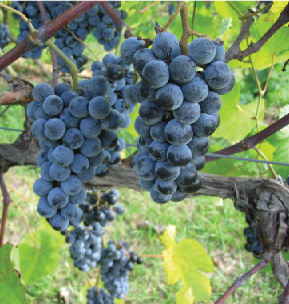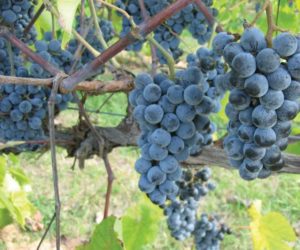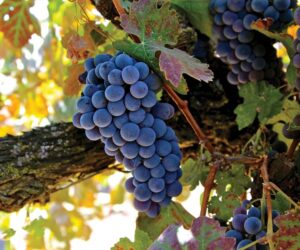 The history of winemaking in the United States dates back to the first settlements. The first Europeans referred to the New World as “Vineland.” Vitis riparia, V. labrusca, V. aestivalis and Muscadinia rotundifolia were just a few of the varieties they encountered.
The history of winemaking in the United States dates back to the first settlements. The first Europeans referred to the New World as “Vineland.” Vitis riparia, V. labrusca, V. aestivalis and Muscadinia rotundifolia were just a few of the varieties they encountered.
However, the flavors present in these native grapes and subsequent wines were subject to significant criticism and most felt it would be better if the European vines could be introduced to the New World. Enter V. vinifera varietals. As the vinifera cuttings were established in the New World, settlers found the vines succumbed to diseases, presumably viruses and the dreaded phylloxera to which they had no natural resistance.
While grape breeding to produce grapes of better quality and disease-resistance was popular in the New World, the appearance of Norton seems to have been accidental. The experts surmise Norton is likely a cross between V. aestivalis and an unknown V. vinifera species. There is possibly some contribution of V. labrusca. Some indicators of this possible parentage are indicated by the way that Norton is poorly propagated from cuttings, a characteristic of V. aestivalis. Other contributing factors leading to this speculation are that Norton is a self-pollinating varietal, a characteristic of vinifera species. If present, however, the vinifera parentage is unknown. A descriptor of the wine produced from the grape includes slightly “foxy,” which is indicative of V. labrusca.
To learn the origins of the varietal, we introduce Dr. Daniel Norborne Norton of Richmond, Virginia. A medical doctor by training, Norton was also referred to as a “backyard hybridist.” The writings about Dr. Norton don’t really clarify whether he was a grape breeder, general plant breeder or just someone with a green thumb and a big garden. He is reported to have tinkered with a number of plants — grapes not being one of them. In fact, Norton is the only commercial varietal he produced. But that’s just what leads to the mystery surrounding Norton; the person, Norton; the grape and Norton; the wine.
The investigations into Norton’s varietal origins are all from secondhand accounts of Dr. Norton’s work. The story as presented by John McGrew, retired from the United States Department of Agriculture, goes somewhat like this: Sometime around 1820 Norton cultivated a seed, which produced the vine that bears his name. Then by the 1830s it was commercially available. What is so intriguing is that Dr. Norton kept no records and the origins of the seed can only be surmised. The best account is that Dr. Norton didn’t even intentionally cross-breed two varieties, rather he collected seeds from around Richmond, cultivated them and found a suitable varietal for making wine. Or possibly, a bird or other animal may have consumed a grape in his garden and then deposited the seed somewhere else in his garden where it sprouted and was discovered. However it came to be, Dr. Norton cultivated the “accidental” vine and after a few years, he realized that it had the desirable vigor characters, pest and disease resistance, and fruit quality to be a commercial varietal.
Although Norton, the vine, acquired its name from Norton, the person, the custom of the day was to name horticultural varieties for someone the discoverer held in high regard or another object of admiration. In the case of Norton, the wine, presumably Dr. Norton was a good winemaker, thus there was considerable demand for Dr. Norton’s Claret. From there the name just stuck.
With his discovery, the good doctor likely had to find a way to produce the vines since the normal method of propagation was not successful. This could be why it took many years for the vine to become commercially available. The normal method of propagation of grapes was achieved by placing cuttings with exposed buds in a nutrient-rich soil and allowing the buds to push, and then the roots would follow. Grafting of buds to various rootstocks is also another method in use today to improve resistance to pests and diseases. Dr. Norton didn’t have to do this, as he had a variety that was apparently resistant to pests and diseases. He likely experimented with different techniques and, having the green thumb he presumably had, realized that the vines could produce roots by burying cuttings, which would sprout roots and then a shoot. Once the leaves are formed, he would dig up the now sprouting cane, isolate the new root and shoot growth, and presto! He had a vine genetically identical to the cutting he buried. This process came to be known as “layering.”
But this story as told is not without a controversy in itself. In 1861, an article was published in The Horticulturist by a writer who claimed that Norton was discovered in 1835 by his father, Dr. F.A. Lemosy, on a riverbank in the Richmond area and that Dr. Norton secured the varietal from him. This controversy seemed to erase all the efforts that Norton had undertaken over the previous 40 years to promote the varietal. While Dr. Norton’s fame was somewhat deflated, the popularity of the vine and number of plantings increased — expanding to Missouri and other areas to the east and south because of the plant’s heartiness and propensity for making good wine. With the onset of Prohibition, many vineyards were re-placed, and the popularity waned, only to find new resurgence in Missouri, Virginia and Arkansas.
The wines resulting from good quality Norton grapes, generally grown in the Midwest, are characterized by high to very high acidity. The one Norton example I am aware of in California is of lower acidity, typical of many of the other red varieties in the Golden State. The shorter growing seasons in the Midwest and East seemingly lend a more desirable acidity pattern to balance the red and black fruit characters. One reference I found also described coffee and bittersweet chocolate as some flavor descriptors.
The distinctive “foxy” character present in other North American grape varieties is not as prominent in Norton, which was one of the reasons that it held great favor as commercially viable wine among its supporters. The wines are of medium weight color, and tend to have more anthocyanin color than other native North American reds. The commercially available wines are either dry or Port-style. In Arkansas, Norton is referred to as the “Cabernet of the Ozarks.” Others have likened the Norton grape to Zinfandel.
In my section about Zinfandel (on page 44) I herald its history as America’s grape. In reality, Zinfandel was America’s grape until the geneticists proved otherwise. There are many people who want to give Norton that claim. In light of Dr. Norton’s apparent fall, this would bestow on him an honor some say he deserves. His devotion to promoting Norton is the same that is seen with the current producers. This can easily be justified for what is America’s oldest native cultivar.
Norton Recipe
yield: 5 gal/19 L
Ingredients
• 50 pounds (23 kg) Norton fruit or 4 gallons (15 L) of fresh juice (target 23 °Brix)
• Distilled water
• 5 grams Red Star Premier Cuvée yeast
• 3 grams Di-ammonium Phosphate (DAP)
• 5 grams Go-Ferm
• 5 grams Fermaid K (or equivalent yeast nutrient)
• About 2 gallons (7.6 L) of Brandy, 80 proof, preferably clear
• 15% potassium metabisulfite (KMBS) solution: To make, weigh 15 grams of KMBS, dissolve into about 75 milliliters (mL) of distilled water. When completely dissolved, make up to 100 mL total with distilled water.
Other equipment or needs
• 15-gallon (57-L) food-grade plastic bucket for fermentation
• 5-gallon (19-L) carboy
• (1 or 2) 1-gallon (3.8-L) jugs
• Racking hoses
• Inert gas (nitrogen, argon or carbon dioxide)
• Thermometer capable of measuring between 40-110 °F (4-43 °C) in one degree increments.
• Ability to maintain a fermentation temperature of 80-85 °F (27-30 °C). TIP: prior to harvest, buy several 1-liter bottles of water, drink the water, replace with your tap water and freeze. Sanitize the outside of the sealed bottles and add them to the fermenter during peak fermentation. If you have other means to keep things cool, of course use that.
Step by step
1. Clean and sanitize all your winemaking tools, supplies and equipment.
2. If you are using fresh fruit, crush and destem the grapes. Transfer the must or juice to your fermenter.
3. Layer the headspace with inert gas and keep covered. Keep in a cool place overnight.
4. Measure the Brix, acidity and pH.
5. Dissolve the DAP in as little distilled water required to completely go into solution (usually ~ 20 mL). Add to must or juice and mix well.
6. Prepare yeast. Heat about 50 mL distilled water to 108 °F (42 °C). Mix the Go-Ferm into the water to make a suspension. Pitch the yeast when the suspension is 104 °F (40 °C). Sprinkle the yeast on the surface and gently mix so that no clumps exist. Let sit for 15 minutes undisturbed. Measure the temperature of the yeast suspension. Measure the temperature of the juice. You do not want to add the yeast to your cool juice if the difference in temperature of the yeast and the must exceeds 15 °F (8 °C). To avoid temperature shock, acclimate your yeast by taking about10 mL of the juice and adding it to the yeast suspension. Wait 15 minutes and measure the temperature again. Do this until you are within the specified temperature range. Do not let the yeast sit in the original water suspension for longer than 20 minutes. When the yeast is ready, add it to the fermenter.
7. When the yeast is ready, add it to the fermenter and mix.
8. You should see signs of fermentation within about a day. This will appear as some foaming on the must surface and it will appear that the berries are rising out of the medium. If you have used whole grapes, this is referred to as the “cap rise.”
9. If you are using grapes, have on hand the ability to push the grapes back into the juice to promote color, and tannin extraction. This is called “punching down.” This should be done about three times per day.
10. At about 19 °Brix, sprinkle in the Fermaid K and mix. If you are using grapes, just put it directly on to the cap and mix it in as part of your punchdown.
11. Monitor the Brix and temperature twice daily. If the temperature exceeds 85 °F (29 °C). Place the frozen water bottles in the fermentation. Mix the must. Wait 30 minutes, mix and check the temperature again. Do this as often as it takes to keep the temperature down, but do not cool off to less than 80 °F (26 °C).
12. When the Brix reaches 10 °Brix, measure more frequently as you will want to add your brandy to stop the fermentation at 8 °Brix. This is very important. Don’t miss this target!
13. At 8 °Brix, press off the fermenting juice from the skins and seeds. Place the still fermenting juice in the carboy and estimate the volume. The other information you will need is the alcohol concentration of the brandy, the estimated alcohol content of the wine and the target alcohol of your Port. For those latter two figures assume 9% and 20%, respectively.
a. Calculate the volume of brandy to add based on the volume of juice obtained. A handy online calculator can be found at www.vinoenology.com/calculators/fortification.
b. The fermentation should cease.
14. Add 35 ppm sulfur dioxide.
15. Place the wine in a cool place to settle.
16. Rack the wine once or twice over 8-12 months to clarify. Fining and/or filtration are generally not needed. Add 20 ppm sulfur dioxide to the wine at each racking.
17. Once the wine is cleared, it is time to move it to the bottle. This should be about 12 months after the completion of fermentation. Check the SO2 levels and verify that it is about 35 ppm. Adjust if necessary.
Notes:
• Yields are assumed based on 5 gallons (19 L) of juice per 100 pounds (45 kg) of grapes using a crusher/destemmer and basket press. Your actual yields may vary based on equipment used.
• The recipe calls for specific additions of sulfur dioxide at specified intervals. Once these scripted additions are made, you must monitor and maintain 30-35 ppm SO2, adjusting as necessary using the potassium metabisulfite solution previously described or by methods of your own choosing.







